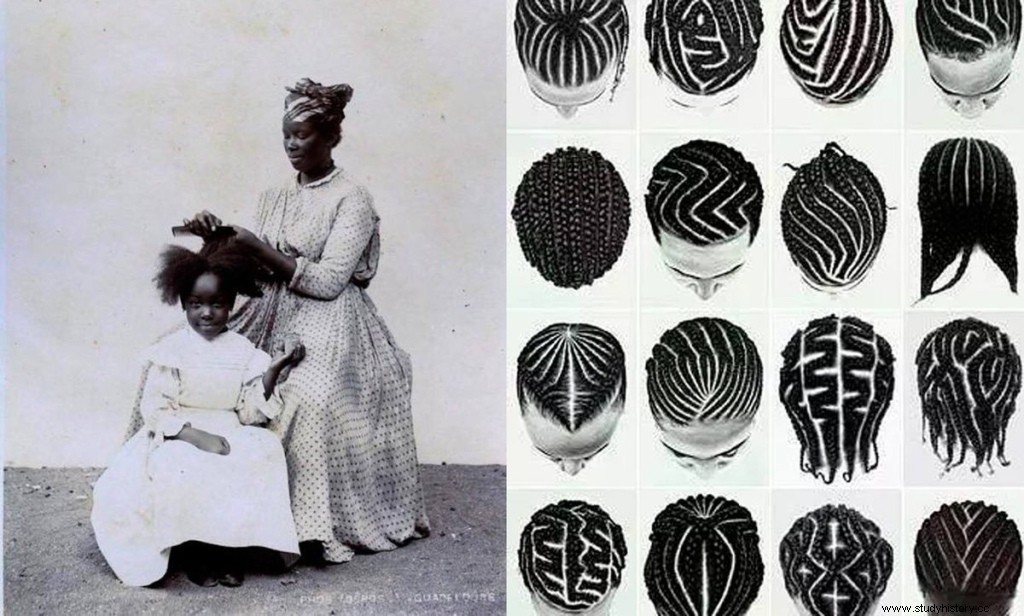I remember a trip to the Caribbean a few years ago in which all the women in the group decided to do their hairstyle with African or African-American braids. The essential requirements to put yourself in the hands of these street artists, because the truth is that it requires a lot of skill, are long hair and a lot of patience, especially on the part of the companions. The end result is a latticework, sometimes almost geometric, of small tight braids all over the head and adorned with colored threads and beads. Come on, that's the option they chose, because there really were many combinations. And to date it is simply a matter of aesthetics, original and carefree, but purely aesthetic. But the story of these braids hides a more important question:the path to freedom.

It is difficult to pinpoint the origin of this type of hairstyle, but what can be confirmed is that in the tribes of sub-Saharan Africa it was a sign of identity, whether it was their social status, their ethnicity or, simply, their age. Precisely, the area where the Africans that the Europeans would enslave and take to the American continent since the 16th century were captured. When they were shipped, according to the slavers for hygiene reasons, their hair was cut and, without knowing it, they were being stripped of their tribal roots.

Although they tried to subdue them with blows, whips and punishments, resistance to the new condition of slaves became the new hallmark of those Africans born free. Many of them opting for passive resistance (working without much effort, boycotting crops, breaking tools and, ultimately, committing suicide), and others through active resistance, provoking riots and trying to escape. In fact, at the end of the 16th century, fugitive slaves in the Caribbean area and in the Kingdom of New Granada, called cimarrones , had become a problem for the Spanish Crown. And not only because of the flight and loss of labor, but because they organized themselves into gangs and raided farms to free more slaves. They even came to form communities organized according to African models and settlements in places of difficult access (palenques or quilombos ). In these communities, the Africans lived by pillaging nearby farms, hunting, planting the surrounding land, and smuggling, either with European merchants or pirates. Logically, the Crown sent expeditions against these fugitive communities, but it was not easy to locate the settlements or defeat them in the thick of the forest or in the rugged mountains. So, on many occasions, the Spanish authorities had no choice but to sign agreements in which they promised to respect their existence in exchange for not accepting more escaped slaves and not raiding more haciendas. Later, some of these settlements were the origin of populations that have survived to this day, such as San Basilio de Palenque, in Colombia, or Palenque in Mexico.
And what do braids have to do with maroons? Well, oddly enough, they had to see. Logically, the first slaves who escaped had no other motivation than flight, yes or yes. They didn't know what they would do, where they would hide, how they would survive… only to escape and not be caught. When the escapes began to be planned, it was essential to know the orography of the place, the rivers, the forests or the roads, and the women took care of this. Being considered less dangerous, the slaves had a certain freedom of movement that allowed them to know the environment that surrounded them much better than them, confined to the plantation and closely watched. Faced with the impossibility and danger of capturing on paper or in another medium the details that would facilitate the escape, they decided to represent those maps with the African braids.

That innocent picture in which the older African women, with their typical headscarf that held their rebellious Afro hair, braided the young women, hid the local cartography. Everything they saw and considered relevant was being added to those capillary maps. In this way, they did not have to memorize all the details, they could consult it at any time and, best of all, in front of their masters and without raising suspicions. For the lord of the estate, it was nothing more than an African hairstyle of small intertwined braids that formed figures. When the cimarrons established in communities, the braid designs went from being just local maps that facilitated escape to becoming authentic escape routes to reach the sanctuaries of freedom, the palenques.
And to finish off the job, it is also said that when making the braids, seeds were intermingled that, later, would be planted in the surroundings of the palenques.
